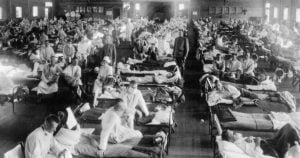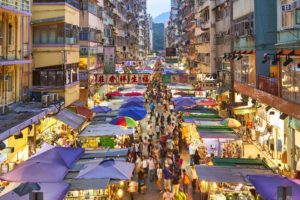Pandemics are not just a force of nature. They sometimes arise out of nothing, but usually are the result of humans and their relationship with nature. It is quite tempting to see how a virus comes to us as a hostile force, arises from the depth of nature, confronts us and then we need to protect ourselves against that. History shows us that pandemics have always played a role in human development, as they often exposed fault lines running through society.
When the pandemic hits and the aftermath of the pandemic become clear, then we are left with an exposure of the fault lines, developments that were already at play before the pandemic hit. The pandemic does nothing but bring them to the surface and initiates a process of change through which societies are forced to reflect upon themselves and perhaps make the changes necessary.
Pandemics arise in social, political, and economic contexts and affect human societies in different ways.
It is worth looking at the interrelationship between human societies and their natural surroundings because this is not the first time a global pandemic has a long-standing history.
COVID-19 is something that we have never experienced before. The total closure of places in countries in public life, lockdown’s social distancing. All those concepts are new for many of us, even though in response to the Spanish flu. Even though it is new for many of us in our generation, there have been many warning signs (not COVID) of other potentially lethal diseases that perhaps didn’t spread as quickly as COVID has done, hit us in the last few decades such as Avian flu (1997) and flu strain of H1N1 in 2009, the swine flu potentially even more lethal.
Table of Contents
History of Pandemics
Over time, humanity creates a precarious balance with its natural environment where bacteria and viruses are spreading around. Still, there is a controllable condition because humans develop this immunity against known pathogens. Once these patterns and developments are broken by some innovations or new economic developments, then suddenly, a new pathogen/virus/bacteria could potentially hit very hard, taking the communities down and creating massive change in its wake.
Let us have a look at flu in the 20th century, i.e., Spanish flu which swept through the trenches at the end of World War-I, quickly wiped out 100 million people. It was such severe disease that a relationship between different countries quickly became a central part of the international infrastructure, which became part of the United Nations after World War-II in 1947. It is known as the global influenza program, as part of the World Health Organization and the United Nations. It became a worldwide program focused on vaccinations and on how to tackle these outbreaks when they would happen. It became almost a founding principle upon which countries started working together as an international community. Hence, it is also a link to today’s challenge.
Therefore, there is something that we can think about when we look at the COVID challenges that we face together in this day and age.

The Economic of Diseases
Economics matters, especially when considering how societies protect and organize themselves against pathogens. Our world today is something that deserves a little bit more attention. There are lots of differences if we compare the World today, 2020, with the world a hundred years ago. Up to 1929, we existed in a world where open markets were dominant, the powers like Britain, France, who had colonies, had monopolies on various products. In 1929, when the world economy collapsed, the countries felt it necessary to protect their economies. The collapse of capitalism was so severe that it created the rise of a whole new system. It developed under the charge of the state governments, who intervened in the economic relationships, redistribute some of the wealth through taxation. Public health systems seemed to make sense in the wake of World War-II, but they soon came under enormous pressures. And until the oil crisis of 1973, this was the accepted economic paradigm. After 1973, all changed, and the idea of neo-liberalism started gaining popularity. Neoliberalism is a policy model that comprises both politics and economics. Many neoliberalism policies enhance the workings of free-market capitalism and attempt to place limits on government spending, government regulation, and public ownership.
Industrial Farming and Diseases
Our modern, globalized economy has created enormous industrial farms – factories of meat production – which inevitably harm both animals and the societies in which they exist, creating the ideal conditions for pathogens to arise.
This is an important fact that both flu strains (Spanish and COVID) originated in Guangdong, China, which is the world’s manufacturing hub. This could be a coincidence, but it is not. In this manufacturing hub, a lot of Chinese products are being produced so there’s a lot of people concentrated in that area compared to the industrial revolution of the 19th century where large numbers of people were concentrated in these new industrial cities, exposed to different pressures that they hadn’t been exposed to previously.
In Guangdong, there is also a food production going on. These factories have a very narrow escape and when you pack millions of human beings into unprecedently dense, often unsanitary space, surround those cities with factory farms crowded with vast concentrations of pigs and chickens, you get a more fertile breeding ground for emerging disease than any of our species had ever seen.

Destruction of Natural Ecosystem
The destruction of ecosystems is something that lies at the heart of our current pandemic and perhaps previous pandemics as well. Deforestation can also be considered as a massive part of the discussion because it affects the habitats to such an extent.
The transmission of wild animal disease to humans is greatly accelerated due to,
1) clearance of tropical force for farm animals feeding,
2) Logging companies turn forestry into profit through timber,
3) the problem of high fuel prices that has driven people away from traditional sources of protein and towards consuming in ever-increasing numbers in the flesh of wild species.
The food prices are steadily rising which pushes more people into poverty and forces people in certain situations to turn towards the food source. They would not necessarily turn to increase the rate of exploitation of the natural environment, which in turn generates conditions for viruses or pathogens to spread, from animal or natural environment towards humans. So rather than saying that the virus comes from China, it happens to have originated there.
But it is the result of the interplay of all these different factors which have made it such a lethal pandemic.
Lessons Learnt from the Pandemics
The way we interact with our environments, organize our food production, interact with the animals that we bring under control; they are all factors that need to be reflected upon. There is no long-term solution in the face of this pandemic; if we are not willing to consider these structural changes, it is almost like climate change, something which faces all of us.
The people who have little faith in our institutions, scientists, and political leaders, that they think the whole thing is a hoax, does not help our societal response to this challenge. There are situations in which scientists are working together, even though social distancing measures are in place. We have seen quite beautiful examples of collaboration between different communities, rediscovering our neighbourhoods that were needed during this last period, helping each other. It can lay the foundation for something much more structural to change and to defeat that idea. We have this collective experience and we can rebuild with our response to climate change.
But on the other hand, not treating this as a wakeup call would be foolish and would be repeating the mistakes we made when the Spanish flu wiped through whole societies. Social distancing or self-isolation works very well if you have got a villa and a lot of space and some wealth to get through. But if you are in a tiny little flat in a suburban area, it is a lot harder. So, it exposes all these factors.
We have the luxury of looking away for a little bit maybe or at different times. Still, at the end of the day, it will require us to make structural changes and to change the way we live and interact with our planet. Summing up, we need to find a solution, not just focus on the technicalities of the pandemic. If that can happen, then who knows what changes might be achieved. We might go all the way and get climate change sorted, as well as our relationship with nature and with the planet minimizing the risk of these types of pandemics to occur.
